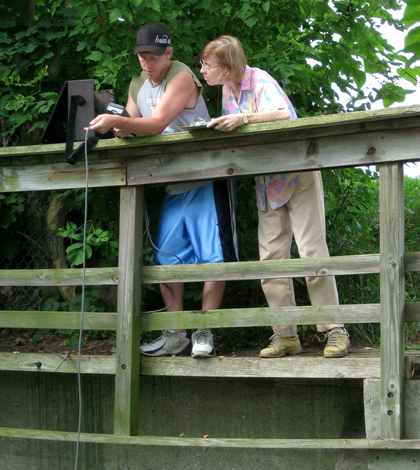Watershed groups handing tech to volunteers for better citizen monitoring

Watershed protection groups across the country are collecting water quality data on waterways that might otherwise miss out on monitoring entirely. Some have found that, despite small staffs, they can compile more high-quality data by putting water quality sensors and other professional scientific instruments in the hands of volunteers.
For organizations like the Santa Barbara Channelkeeper, the reasoning for equipping volunteers with electronic handheld meters is clear:
“We really want the data that we’re collecting to be utilized,” said Ben Pitterle, director of the group’s watershed and marine program. Past citizen monitoring efforts in the area have relied on take-home kits that included tools like color-changing pH strips that, while helpful and easily entrusted to amatuer scientists, didn’t do much for decision makers like state agencies. While taking a more costly, high-tech route for their Stream Team program means the Channelkeeper group can’t distribute tools to as many volunteers, “the upside is the data we collect hasn’t been criticized to the degree that a lot of citizen monitoring gets,” Pitterle said.
Their monitoring, which also includes laboratory analysis of samples for nutrients and bacteria, has been used “significantly” by the state, he said. It has contributed to the listing of waters as impaired under the Clean Water Act as well as Total Maximum Daily Load standards for the Ventura River.
But that high-level use of volunteer data isn’t a given. It usually requires training programs that have been approved by state or federal agencies as part of a larger quality assurance and quality control plan. For volunteers with the Neponset River Watershed Association in Massachusetts who measure dissolved oxygen with handheld meters, that amounts to an annual class on how to use and calibrate the instruments, followed by a round of hands-on training. According to the group’s environmental engineer Sarah Bounty, the volunteers might be intimidated by the technology at first, but that tends to fade.
“I usually tell them that it’s actually easier than taking the water samples, so they should feel good about it,” Bounty said. “By the end of the season, they all feel pretty confident.”

Data collected by Santa Barbara Channelkeeper volunteers have been used significantly by the state. (Credit: Santa Barbara Channelkeeper)
The Neponset’s Citizen Water Monitoring Network has around 50 volunteers who collect samples from 41 sites throughout the 117-square-mile watershed. Just seven volunteers are trained on dissolved oxygen meters, and each measures oxygen at five or six sites during the group’s monthly sampling events scheduled throughout the field season. Those measurements showed low oxygen levels across the watershed in the summer of 2014, including readings far below standards set by the state. Without the monitoring network, that drop that might have gone unnoticed.
“Our group is the only group that does any data collection for water quality around the Neponset, at least consistently,” Bounty said. “Every month, every year for the six months we do it.”
Volunteers with the Huron River Watershed Council in Michigan also spend a few hours in the classroom with a suite of high-tech tools before a day of field training, according to Ric Lawson, the group’s watershed planner. Newer volunteers for their Water Quality Monitoring Program are paired with more experienced participants before heading out on their twice-monthly sampling events on tributaries throughout the watershed.

Huron River Watershed Council volunteers work with flow meters, shown here, as well as water level loggers and other tools. (Credit: Huron River Watershed Council)
The council’s volunteers could find themselves working with a flow meter, water level loggers, a multi-parameter sonde or even an autosampler to capture runoff during storm events. Lawson, who manages the watershed council’s equipment inventory, says he has no qualms with the volunteers working with the less expensive, more rugged instruments. Though he’s a little more anxious over the more sensitive and costlier tools, the volunteers are generally well aware of the instruments’ value and are very cautious with them.
“We’ve certainly broken some DO membranes here and there, but the professional will do that too,” Lawson said.
If anything, the volunteers are more cautious than they need to be, he said. But that’s likely because they’re invested in the work they’re doing. “They want the data to be used,” he said.
Lawson said the watershed council is always working on new projects that try to take advantage of their volunteers’ interests enthusiasm about getting out in the field where they’re “experiencing the environment as well as collecting usable scientific data.” So far, integrating technology into that mix has worked out well for them.
But it’s not clear that will always be the case. Pitterle of the Santa Barbara Channelkeeper has been pondering how more advanced technology might actually reduce the work they have for volunteers. For example, a few years ago, Pitterle said the group rounded up “a couple hardcore crews” of volunteers to measure dissolved oxygen at 4 a.m. and again later in the afternoon to capture daily fluctuations. They’ve since upgraded the equipment for that project to deployable sensors that stay in the streams and don’t require such early morning camaraderie.
“Unfortunately, we don’t get the volunteer community interaction with that, but now we’re getting continuous data all summer long for those parameters,” Pitterle said. “The data is just much more valuable and robust.”
That leaves him wondering whether, as technology improves and grows more accessible, they’ll be tempted to replace volunteer monitoring entirely with long-term sensor stations. The cost, of course, would be missing out on the education and outreach components of citizen monitoring.
“And I think there’s something to say for just getting people out and building a sense of stewardship and connection with these waterbodies,” Pitterle said.
Top image: Volunteers with the Huron River Watershed Council measure water quality with a handheld meter. (Credit: Huron River Watershed Council)




Pingback: CWMN Program in the News! | Neponset River Watershed Association